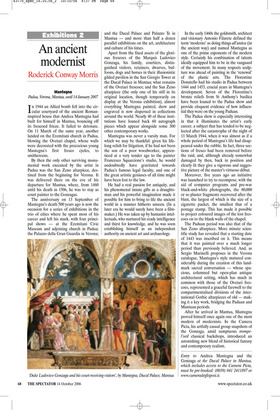An ancient modernist
Roderick Conway Morris
Mantegna Padua, Verona, Mantua, until 14 January 2007
In 1944 an Allied bomb fell into the circular courtyard of the ancient Romaninspired house that Andrea Mantegna had built for himself in Mantua, bouncing off its frescoed frieze. It failed to detonate. On 11 March of the same year, another landed on the Eremitani church in Padua, blowing the Ovetari chapel, whose walls were decorated with the precocious young Mantegna’s first fresco cycles, to smithereens.
By then the only other surviving monumental work executed by the artist in Padua was the San Zeno altarpiece, destined from the beginning for Verona. It was delivered there on the eve of his departure for Mantua, where, from 1460 until his death in 1506, he was to stay as court painter to the Gonzagas.
The anniversary on 13 September of Mantegna’s death 500 years ago is now the occasion for a series of exhibitions in the trio of cities where he spent most of his career and left his mark, with four principal shows — at the Eremitani Civic Museum and adjoining church in Padua; the Palazzo della Gran Guardia in Verona; and the Ducal Palace and Palazzo Te in Mantua — and more than half a dozen parallel exhibitions on the art, architecture and culture of his times.
Apart from the fixed assets of the glorious frescoes of the Marquis Ludovico Gonzaga, his family, courtiers, distinguished visitors, retainers, dwarves, buffoons, dogs and horses in their illusionistic gilded pavilion in the San Giorgio Tower at the Ducal Palace in Mantua; what remains of the Ovetari frescoes; and the San Zeno altarpiece (the only one of his still in its original location, though temporarily on display at the Verona exhibition), almost everything Mantegna painted, drew and engraved is now dispersed in collections around the world. Nearly 40 of these institutions have loaned back 60 autograph pieces which appear alongside some 300 other contemporary works.
Mantegna was never a varsity man. For which we may be thankful: given his lifelong relish for litigation, if he had not been the son of a poor woodworker, apprenticed at a very tender age to the painter Francesco Squarcione’s studio, he would undoubtedly have gravitated towards Padua’s famous legal faculty, and one of the great artistic geniuses of all time might have been lost to the law.
He had a real passion for antiquity, and his phenomenal innate gifts as a draughtsman and his powerful imagination made it possible for him to bring to life the ancient world in a manner hitherto unseen. (In a later era he would surely have been a filmmaker.) He was taken up by humanist intellectuals, who nurtured his ready intelligence and thirst for knowledge, and he was soon establishing himself as an independent authority on ancient art and archaeology. In the early 1460s the goldsmith, architect and visionary Antonio Filarete defined the term ‘moderno’ as doing things all’antica (in the ancient way) and named Mantegna as one of the prime exponents of the modern style. Certainly his combination of talents ideally equipped him to be in the vanguard of the movement. In many respects sculpture was ahead of painting in the ‘renewal’ of the plastic arts. The Florentine Donatello had his studio in Padua between 1444 and 1453, crucial years in Mantegna’s development. Seven of the Florentine’s bronze reliefs from St Anthony’s basilica have been loaned to the Padua show and provide eloquent evidence of how influential they were on the young Paduan.
The Padua show is especially interesting in that it illuminates the artist’s early career, a subject that has tended to be neglected after the catastrophe of the night of 11 March 1944, when it was almost as if a whole period of Mantegna’s life had disappeared under the rubble. In fact, three sections of fresco had been removed before the raid, and, although already somewhat damaged by then, back in position and clearly lit they give a vigorous and suggestive picture of the master’s virtuoso début.
Moreover, five years ago an initiative was launched to try to recompose, with the aid of computer programs and pre-war black-and-white photographs, the 80,000 or so plaster fragments recovered after the blast, the largest of which is the size of a cigarette packet, the smallest that of a postage stamp. This has made it possible to project coloured images of the lost frescoes on to the blank walls of the chapel.
The Paduan period was also that of the San Zeno altarpiece. More minute scientific study has revealed that a starting date of 1443 was inscribed on it. This means that it was painted over a much longer period than previously believed. And, as Sergio Marinelli proposes in the Verona catalogue, Mantegna’s style matured considerably during the creation of this landmark sacred conversation — whose spacious, columned but open-plan antique architectural setting, which has much in common with those of the Ovetari frescoes, represented a graceful farewell to the compartmentalised divisions of the international Gothic altarpieces of old — making it a key work, bridging the Paduan and Mantuan periods.
After he arrived in Mantua, Mantegna proved himself once again one of the most modern of modernists. In the Camera Picta, his artfully casual group snapshots of the Gonzaga, amid sumptuous trompel’oeil classical backdrops, introduced an astonishing new blend of historical fantasy and contemporary realism.


































































































 Previous page
Previous page